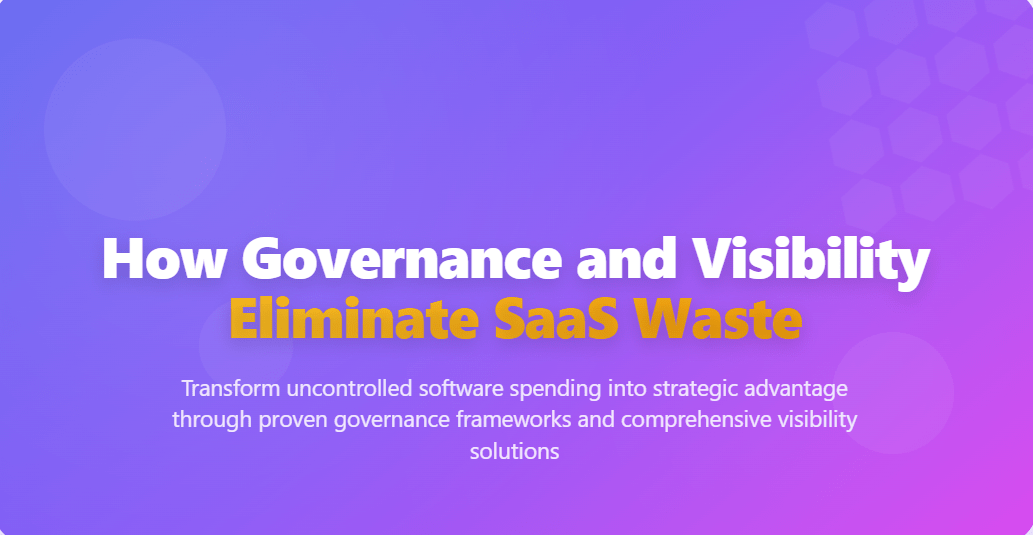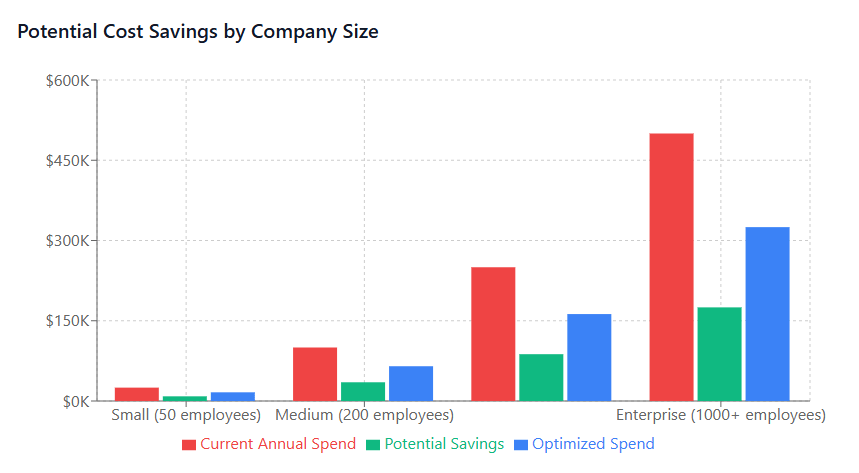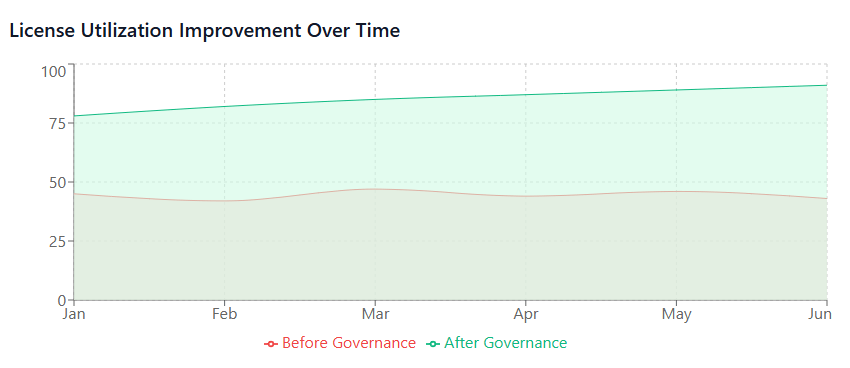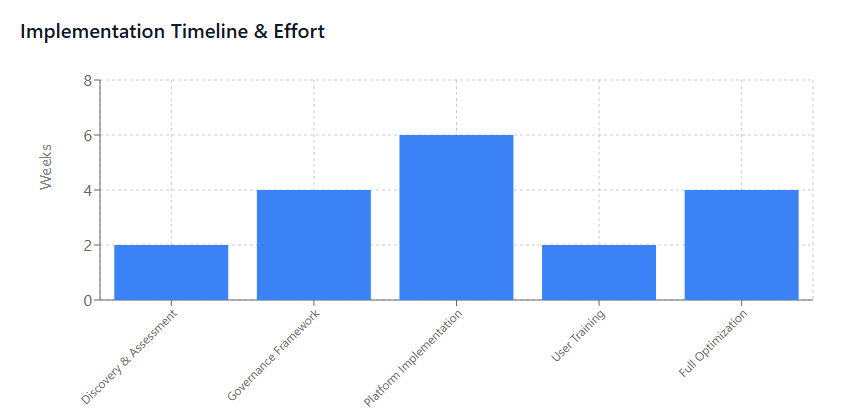
The rapid adoption of Software as a Service (SaaS) applications has fundamentally transformed how organizations operate in the digital age. While SaaS solutions offer unprecedented flexibility, scalability, and accessibility, they have also introduced a new challenge: SaaS waste. Without proper governance and visibility, organizations find themselves drowning in subscription costs, unused licenses, and redundant applications that drain resources and compromise operational efficiency.
This comprehensive guide explores how implementing robust governance frameworks and establishing clear visibility into SaaS spending can eliminate waste, optimize costs, and maximize the value of your software investments. By understanding the root causes of SaaS waste and implementing strategic solutions, organizations can harness the full potential of cloud-based software while maintaining fiscal responsibility.
Understanding SaaS Waste in Modern Organizations
SaaS waste manifests in various forms across organizations, often hidden within the complexity of modern software ecosystems. Unlike traditional on-premises software with clear licensing models, SaaS applications operate on subscription-based pricing that can quickly spiral out of control without proper oversight.
The most common types of SaaS waste include unused licenses where organizations pay for user seats that remain inactive, redundant applications where multiple tools serve similar functions across different departments, and feature bloat where companies subscribe to premium plans with capabilities they never utilize. Additionally, organizations often experience ghost subscriptions – forgotten trial periods that automatically convert to paid plans, or services that continue billing long after they’ve been abandoned.
The distributed nature of SaaS adoption compounds these issues. Unlike traditional IT procurement processes, SaaS applications can be easily purchased with a corporate card, leading to shadow IT where departments independently subscribe to services without central oversight. This decentralized approach, while enabling agility, creates visibility gaps that make it nearly impossible to track total SaaS spending across the organization.
According to recent industry research, organizations typically waste 30-40% of their SaaS spending on unused or underutilized applications. For a company spending $100,000 annually on SaaS tools, this represents $30,000-$40,000 in direct waste – resources that could be redirected toward strategic initiatives or additional capabilities that drive business value.

The Critical Role of Visibility in SaaS Management
Visibility serves as the foundation for effective SaaS management and waste elimination. Without comprehensive insight into what applications are being used, by whom, and to what extent, organizations cannot make informed decisions about their software investments. This visibility must extend beyond simple subscription lists to include detailed usage analytics, user behavior patterns, and cost allocation across departments and projects.
Comprehensive SaaS visibility encompasses several key dimensions. Application discovery involves identifying all SaaS applications across the organization, including both sanctioned tools procured through official channels and shadow IT applications acquired independently by teams. User activity tracking monitors how actively licensed users engage with each application, identifying inactive accounts and underutilized subscriptions. Cost attribution maps spending to specific departments, projects, or business units, enabling accurate budget allocation and accountability.
Modern SaaS management platforms leverage automated discovery techniques to identify applications connected to corporate networks, email systems, and identity providers. These platforms can detect SaaS usage patterns through various signals, including network traffic analysis, email receipt scanning, and integration with single sign-on (SSO) systems. This automated approach ensures comprehensive coverage while reducing the manual effort required to maintain accurate inventories.
The implementation of centralized dashboards provides stakeholders with real-time insights into SaaS spending and utilization. These dashboards aggregate data from multiple sources, presenting unified views that enable quick identification of optimization opportunities. Interactive visualizations allow users to drill down into specific applications, departments, or time periods, facilitating detailed analysis and informed decision-making.
Regular SaaS audits complement automated monitoring by providing structured reviews of application portfolios. These audits involve systematic evaluation of each application’s business value, usage levels, and alignment with organizational objectives. By conducting quarterly or semi-annual audits, organizations can identify applications that no longer serve strategic purposes and make data-driven decisions about renewals or cancellations.
Establishing Effective SaaS Governance Frameworks
Governance provides the structure and processes necessary to manage SaaS applications strategically while preventing waste. An effective governance framework establishes clear policies, procedures, and accountability mechanisms that guide SaaS procurement, usage, and lifecycle management across the organization.
The foundation of SaaS governance lies in establishing clear policies that define acceptable use, procurement procedures, and approval workflows. These policies should specify who has authority to purchase SaaS applications, what evaluation criteria must be applied, and how new applications should be integrated into existing workflows. Additionally, governance policies should address security requirements, data privacy considerations, and compliance obligations that affect SaaS adoption.
Centralized procurement processes ensure that all SaaS acquisitions flow through designated channels where they can be properly evaluated and approved. This centralization doesn’t necessarily slow down adoption but rather ensures that purchases align with organizational standards and complement existing capabilities. Procurement teams can negotiate better pricing through volume discounts, standardize contract terms, and maintain comprehensive records of all SaaS investments.
Role-based access controls form another critical component of SaaS governance. These controls ensure that users receive appropriate access levels based on their job responsibilities while preventing unnecessary license assignments. Regular access reviews help identify users who no longer require specific applications, enabling organizations to reclaim unused licenses and reduce costs.
Governance frameworks should also establish clear ownership and accountability structures. Application owners should be designated for each SaaS tool, with responsibility for monitoring usage, managing user access, and evaluating ongoing business value. These owners serve as primary contacts for vendor relationships and ensure that applications continue to meet organizational needs.
Regular governance reviews provide opportunities to assess the effectiveness of existing policies and make necessary adjustments. These reviews should evaluate metrics such as compliance rates, cost savings achieved, and user satisfaction levels. By continuously refining governance approaches, organizations can adapt to changing business needs while maintaining effective control over SaaS spending.
Advanced Strategies for SaaS Waste Elimination
Beyond basic visibility and governance, organizations can implement advanced strategies that proactively identify and eliminate SaaS waste. These strategies leverage automation, analytics, and predictive capabilities to optimize SaaS portfolios continuously.
Usage-based optimization involves analyzing detailed utilization patterns to identify optimization opportunities. This analysis goes beyond simple login metrics to examine feature usage, data consumption, and workflow integration. Applications with consistently low utilization rates become candidates for downgrades, consolidation, or elimination. Conversely, heavily utilized applications may warrant upgrades to more cost-effective enterprise plans.
Automated rightsizing tools can continuously monitor subscription levels and recommend adjustments based on actual usage patterns. These tools track user activity over time and suggest optimal subscription tiers that match real consumption levels. For example, if a team consistently uses only basic features of a premium application, automated systems can recommend downgrading to a standard plan with significant cost savings.
Duplicate application detection identifies functional overlaps across the SaaS portfolio. Many organizations unknowingly maintain multiple applications that serve similar purposes, often because different departments selected tools independently. Advanced analytics can identify these overlaps by analyzing application categories, features, and usage patterns, enabling consolidation opportunities that reduce both costs and complexity.

Predictive analytics can forecast future SaaS needs based on historical usage trends, business growth projections, and seasonal patterns. These forecasts enable proactive planning for subscription adjustments, helping organizations avoid over-provisioning while ensuring adequate capacity for business operations. Predictive models can also identify applications at risk of becoming underutilized, enabling early intervention to prevent waste.
Contract optimization strategies focus on negotiating better terms and pricing structures with SaaS vendors. Organizations with comprehensive usage data can leverage this information during contract negotiations to secure volume discounts, flexible pricing models, or favorable termination clauses. Understanding actual usage patterns also enables organizations to choose pricing models that align with their consumption patterns, such as per-active-user pricing instead of per-seat licensing.
Implementing SaaS Management Platforms
Modern SaaS management platforms provide integrated solutions that combine visibility, governance, and optimization capabilities in unified systems. These platforms automate many aspects of SaaS waste elimination while providing the insights and controls necessary for strategic management.
Leading SaaS management platforms offer comprehensive discovery capabilities that automatically identify applications across the organization. These platforms integrate with various data sources, including financial systems, identity providers, and network monitoring tools, to create complete inventories of SaaS applications. Automated discovery ensures that no applications remain hidden and provides accurate baseline data for optimization efforts.
Centralized spend management features aggregate SaaS costs across all applications and vendors, providing unified views of total spending. These features often include budget tracking, variance analysis, and cost allocation capabilities that enable detailed financial oversight. Automated invoice processing can categorize expenses and track spending against approved budgets, highlighting variances that require attention.

User lifecycle management capabilities automate the process of provisioning and deprovisioning user access across multiple SaaS applications. When employees join, leave, or change roles, these systems can automatically adjust their application access according to predefined rules. This automation reduces the risk of maintaining inactive accounts while ensuring that users receive appropriate access without delays.
Renewal management features track subscription renewal dates and automate the review process for each application. These features can generate alerts before renewal deadlines, compile usage statistics for evaluation, and facilitate decision-making about whether to renew, modify, or cancel subscriptions. Automated workflows can route renewal decisions to appropriate stakeholders and ensure that decisions are made before automatic renewals occur.
Measuring Success and Continuous Improvement
Effective SaaS waste elimination requires ongoing measurement and continuous improvement to maintain optimization gains and adapt to changing business needs. Organizations should establish key performance indicators (KPIs) that track progress toward waste reduction goals and demonstrate the value of governance and visibility initiatives.
Cost reduction metrics provide direct measures of waste elimination success. These metrics should track total SaaS spending reduction, cost per user optimization, and savings from application consolidation. Organizations should also monitor cost avoidance metrics that quantify prevented waste through proactive management actions, such as unused license identification and duplicate application prevention.
Utilization metrics measure how effectively organizations use their SaaS investments. Application utilization rates track the percentage of licensed users actively using each application, while feature utilization metrics assess whether organizations leverage the capabilities they’re paying for. Low utilization rates indicate potential optimization opportunities, while improving utilization trends demonstrate successful waste elimination efforts.
Governance compliance metrics evaluate how well organizations adhere to established policies and procedures. These metrics might include the percentage of SaaS applications procured through approved channels, compliance with access control policies, and timely completion of renewal reviews. High compliance rates indicate effective governance implementation and reduced risk of uncontrolled spending.
User satisfaction metrics ensure that waste elimination efforts don’t compromise productivity or user experience. Regular surveys can assess user satisfaction with available applications, identify unmet needs that might lead to shadow IT adoption, and evaluate the impact of optimization decisions on daily workflows. Maintaining high user satisfaction while reducing waste demonstrates successful balance between cost control and operational effectiveness.
Regular benchmarking against industry standards provides context for organizational performance and identifies areas for improvement. Industry reports and peer comparisons can highlight best practices and reveal optimization opportunities that might not be apparent through internal analysis alone. Benchmarking also helps justify continued investment in SaaS management capabilities by demonstrating competitive advantages.
Future Trends in SaaS Governance and Optimization
The SaaS management landscape continues to evolve, with emerging trends that will shape future approaches to waste elimination and optimization. Understanding these trends enables organizations to prepare for changing requirements and opportunities in SaaS governance.
Artificial intelligence and machine learning technologies are increasingly being integrated into SaaS management platforms, enabling more sophisticated analysis and automation capabilities. AI-powered systems can identify complex usage patterns, predict future needs with greater accuracy, and automatically optimize configurations based on organizational behavior. Machine learning algorithms can also detect anomalies in spending or usage that might indicate security breaches or policy violations.
Integration between SaaS management platforms and broader IT management systems is becoming more seamless, enabling holistic views of technology spending and utilization. These integrations allow organizations to optimize their entire technology portfolios, considering relationships between SaaS applications, cloud infrastructure, and on-premises systems. Unified management approaches can identify cross-platform optimization opportunities that might be missed when managing SaaS applications in isolation.
Enhanced vendor collaboration is emerging as SaaS providers recognize the value of helping customers optimize their investments. Progressive vendors are providing more detailed usage analytics, flexible pricing models, and proactive optimization recommendations. This collaboration benefits both parties by reducing churn while maximizing customer value realization.
Conclusion
Eliminating SaaS waste requires a comprehensive approach that combines robust governance frameworks with detailed visibility into application usage and spending. Organizations that successfully implement these capabilities can achieve significant cost savings while maintaining the agility and innovation benefits that SaaS applications provide.
The key to success lies in treating SaaS management as an ongoing strategic initiative rather than a one-time optimization project. Continuous monitoring, regular reviews, and adaptive governance policies ensure that organizations maintain control over their SaaS portfolios while supporting business growth and evolution.
By establishing clear visibility into SaaS spending and usage, implementing effective governance frameworks, and leveraging advanced optimization strategies, organizations can eliminate waste while maximizing the value of their software investments. The result is a more efficient, cost-effective, and strategically aligned technology portfolio that supports business objectives without unnecessary expenditure.
As the SaaS ecosystem continues to evolve, organizations that invest in comprehensive management capabilities will be best positioned to harness new opportunities while maintaining fiscal discipline. The combination of governance and visibility provides the foundation for sustainable SaaS optimization that adapts to changing business needs and market conditions.

